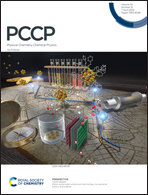Excited-state properties of organic semiconductor dyes as electrically pumped lasing candidates from new optimally tuned range-separated models†
Abstract
Even though many efforts have been devoted to optical lasing in recent years, the realization of lasing by direct electrical excitation of organic semiconductors is hampered mainly due to optical losses from electrical contacts and electrical losses induced by triplets and polarons at high current densities. Hereby, accurately accounting for the electrically pumped organic semiconductor laser diodes (OSLDs) still remains one of the greatest challenges in optoelectronics. In this work, the excited-state characteristics of the organic semiconductor dyes used in the electrically pumped OSLDs have thoroughly been investigated using optimally tuned range-separated hybrids (OT-RSHs). Considering several experimentally known compounds of the electrically pumped OSLDs as working models, several variants of OT-RSHs, their combination forms with the polarizable continuum model (PCM), OT-RSH-PCM, as well as their screened versions accounting for the screening effects by the electron correlation through the scalar dielectric constant, OT-SRSHs, have been proposed for reliable prediction of their emission energies and oscillator strengths in both the gas and solvent phases. The role of involved ingredients in the models, namely, the underlying density functional approximations, short- and long-range exact-like exchange, as well as the range-separation parameter, has been examined in detail. It is shown that the newly designed OT-RSHs with the correct behavior of asymptotic exchange–correlation potential outperform the standard RSHs and other density functionals with both fixed and interelectronic distance-dependent exact-like exchange for describing the excite-state properties of compounds of the electrically pumped OSLDs. Concerning the computational cost of the models, it is unveiled that performing both the optimal tuning procedure and subsequent excited-state computations using OT-RSHs in the gas phase can be considered as a more reliable and affordable framework. Finally, the applicability of the proposed models is also put into a broader perspective for the computational design of several compounds as promising candidates to be used in the OSLD materials. Hopefully, our recommended OT-RSHs can function as efficient models for both the related theoretical modeling and confirming the experimental observations in the field of electrically pumped OSLDs.



 Please wait while we load your content...
Please wait while we load your content...